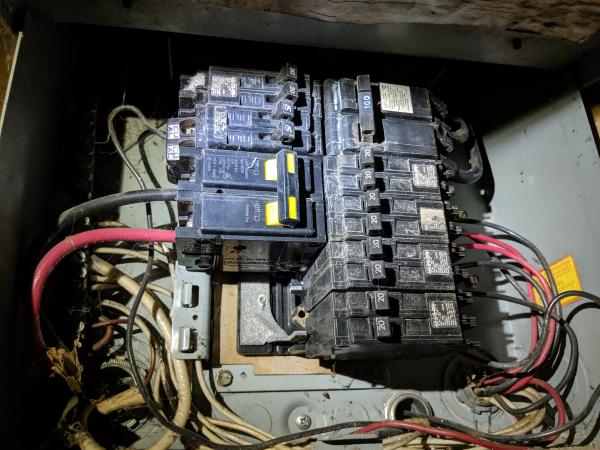This is a case study about modernizing my 1200-square foot East Bay home by removing gas-fired appliances. The gas replacement work was done with some willingness to tolerate temporary inconveniences to minimize cost, which might be helpful for scrappy remodeling projects undertaken by many readers.
Hot Water
In this case an “emergency replacement” instigated the water heater change-out. We came home from vacation to find a shallow pond below the 40-gal gas water heater in the partial basement. It’s been said that nearly all water heater replacements are “emergency replacements” and this puts the owners under stress, with pressure to make quick decisions, at the mercy of products the plumber personally recommends, leading to outcomes worse than if the work were studied, planned, and staged. We agreed to treat the event as an inconvenience and an opportunity, rather than an emergency.
We didn’t rush to install a bad replacement. We were out of hot water for two months, but it was fine: the dishwasher and laundry run on cold water. Because it was summer, our family took cold showers, or showered at a relative’s house, or took sponge baths using hot water from a tea kettle. If I could do again, I would first install a new electrical circuit to serve the replacement water heater, then wire up a temporary, small electric tank water heater purchased off the shelf at Home Depot. This could be done within 1-2 days of mobilizing a tradesperson. It would be enough hot water for short “navy showers” and would provide warm tap water, allowing time to plan the real work and procure final products. This would lower the household’s level of stress and inconvenience. I’d recommend this path to a client and to plumbers and electricians.
What did we install? A powerful SANCO2 heat pump water heater from Heieck Supply in Concord. This heat pump is a “split” system with no refrigerant lines to install, just water pipes connecting an outdoor compressor unit to an indoor storage tank. The outdoor unit is wall-hung from a bracket alongside the house, and it drips clean condensate into a flowerbed below. It purrs: listed at only 39 dBA sound level. I tied a piece of string to the grille to know when the heat pump is on: the string wiggles in the breeze from the fan. This water heater has a relatively tiny amp draw, similar to a toaster. Luckily there was an empty slot in the main load center for a new 15A, 240V, double pole circuit breaker.
I wanted to learn what our early adopter clients and tradespeople would go through, so I installed the water heater myself over many nights and weekends, with training from YouTube videos and help with heavy lifting. My experience shows that the work is straightforward enough that a conscientious person with minimal training and common tools can do it. Unfortunately I don’t have installed costs to share. I see from clients’ shared bids that these can be staggering. With my new experience, I would like to be part of a local gas removal co-op, where members help each other with the installation labor and know-how, to minimize the costs of modernization.
The City offered an “over the counter” water heater replacement permit. They had no trouble with the concept of heat pump water heating (this was new to some jurisdictions), but were concerned that someone might drive a car into the outdoor heat pump. Architect readers will recognize that jurisdictions often have unique and fanciful requirements.
Space Heating
The gas furnace was still working, though loud and uncomfortable like many forced air systems. This was the opportunity to modernize it. I used a less-common design that I wanted to try out: a hot water furnace, rather than an additional heat pump dedicated to space heating/cooling. I installed the new hot water furnace in place of the gas furnace, using the existing ducts. I dismantled the gas furnace piece by piece until the carcass was small enough to remove through the crawlspace door, and I had a pile of scrap metal for the recycling center. This was satisfying.
The heating equipment is a modular blower and a hot water coil (safe for potable water) from Airscape in Medford, OR. The water pump is a variable-speed Laing Vario pump from HVACQuick also in Medford. When the thermostat calls for heat, the water pump moves 140°F hot water from the storage tank to the coil, and the blower moves air across the hot coil to heat the house. Because the supply temperature is less hot than a furnace, with less air flow, it runs silently for a long time and gently stirs the house to achieve more uniform temperatures than the oversized furnace it replaced.
The downside is that this setup provides no active cooling. One benefit of changing a furnace to a heat pump, which clients in hot locations enjoy, is to gain air-conditioning. At this cool site, leaving out air-conditioning was a good compromise to reduce costs.
Laundry + Cooking
Replacing the gas water heater and furnace cut down our gas burning by 90%. There are still two gas-fired appliances remaining in the home: the clothes dryer and cooking range. We’ll be happy to eventually get an electric induction cooktop that doesn’t pollute our indoor air like gas. By now, I hope everyone is aware of the health hazards of gas cooking. I hired an electrician to install 240V receptacles behind the existing gas range and clothes dryer, stapling the new cables in the crawlspace back to the circuit breakers. Because the existing gas cooking and laundry appliances still work and the new electrical outlets are ready, we can take our time to shop for electric replacements.
Gas cooking and laundry are normally loss-leaders for the bigger space heating and water heating gas sales, as our 90% gas savings shows. Frankly it gives me some satisfaction that the remaining cooking and laundry gas loads are a revenue drain for PG&E, hopefully motivating their own resolve to decommission the gas infrastructure.
Electrical Service
After installing the heat-pump water heater, there are no more empty slots in the circuit breaker panel. How can we hook up the new electric range and clothes dryer? A common solution when running out of physical space (but still having enough amperage) is to add a sub-panel. But wait, can the service provide enough amps for these devices?
Because energy calculations for buildings are my profession, I had access to residential service sizing calculations from several electrical engineers. I made a spreadsheet to imitate their calculations and completed it for this home, referencing the California Electrical Code (CEC) sections online, CEC §220.83-220.87. I found we could remove all the gas-fired appliances without exceeding the existing 100A capacity, but we would need a more complicated circuit-sharing device or service upgrade to add a future electric vehicle (EV) charger. As our calculation showed, an EV charger is the main device that drives a service upgrade, and car charging has the biggest impact on grid infrastructure. EVs drive the pace of distribution system upgrades.
We could have simply added a sub-panel to serve the cooking and laundry, no service upgrade required at this time. “A problem deferred is a problem solved.” Unfortunately, I took a more costly approach. I naively asked the electrician to provide the upgrade, a 200-Amp, physically bigger panel. I thought it would be efficient to piggyback this work on the separate new electric meter being added for a backyard Accessory Dwelling Unit (ADU)—another story—but actually this resulted in a cascade of unwanted upgrades and costs.
The 200-Amp panel upgrade triggered all of PG&E’s clearance requirements for a new service, from their Greenbook of service requirements, including proximity to hose bibs and downspouts. Conforming to these will cost as much as the new panel itself. $5,000 had been quoted among peers for panel upgrades. My electrician wants $7,200 for this work, and the general contractor (GC) is marking this up by 1.25x to $9,000. Then, add the Greenbook-triggered relocations of water pipes around the panel, and GC 1.25x markup on these…. Cost explosion for the service upgrade.
It’s notable that PG&E came out publicly in support of the first municipal gas-free ordinance in Berkeley. They really want to avoid sinking more money into gas infrastructure that is ultimately stranded assets. While PG&E does support gas removal, they are not discouraging electric service upgrades. By upgrading electrical service capacities when removing gas, we trigger new upstream capacity requirements that drive the “need” for new electric distribution infrastructure, which is the primary way that PG&E creates profit for shareholders, and this also results in higher rates for customers. It appears that well-intended incentives that fund service upgrades could be better spent on gas appliance replacements. Instead, service upgrade subsidies trickle up to PG&E shareholders through misallocated infrastructure spending.
It turns out that most panel upgrades are unnecessary, since the electrical code for summing the loads has not changed since the 1960s; in reality there is limited overlap of loads. The calculation that I did was by-the-book, but the book is far too conservative. We learned that the actual peak 15-minute electric draw of this mostly gas-free home has been 2.35 kW, only 10% of the 100A panel capacity, using an Emporia Vue: Utility Connect wireless device and phone app to read our PG&E Smartmeter.
In general, we need to avoid service upgrades, because we need this gas removal work affordable enough to scale to all homes—every one—in order to decommission the leaky and dangerous retail gas grid. While it’s true that many architects’ clients doing a remodel can afford a service upgrade and snowballing costs, this is not scalable. In the majority case, by selecting appliances carefully on a “Watt Diet” and by using circuit-sharing devices, most homes can remove gas and stay within their existing electrical service. This approach should be the default assumption until proven otherwise.
• Josie Gaillard and Tom Kabat recorded a webinar available for playback at any time called “Home Electrification Retrofits Without Upsizing the Electric Panel.”
• Josie created the Zero Carbon Home (beta) calculator.
• Redwood Energy created a “Watt Diet” calculator.
• Readers with government connections can get this material onto their city’s electrification website just like the City of Alameda.
I would have taken this approach, if I’d known better before committing to the service upgrade.
A circuit-sharing device or “smart circuit splitter” is relatively new. It lets us install two high-amp devices on a single circuit, say, an oven and a car-charger, by allowing only one of them run: either/or. If the oven is given priority, then it will interrupt the car charger when the oven is turned on. See page 69 of Redwood Energy’s Single-Family Electrification Pocket Guide.
Limiting new EV chargers to 20 amps for “sufficiency” to avoid new infrastructure would be wise to discuss with clients, but the California Energy Commission (CEC) won’t ask citizens to install a slower car charger to ease the spread of unnecessary infrastructure spending—asking citizens to conserve was seen to politically backfire ever since Jimmy Carter famously asked citizens to "live thriftily and remember the importance of helping our neighbors.” At the moment, until utility rates are reformed by the California Public Utilities Commission (CPUC), gas removal and EV chargers appear to be another cost shift from wealthier owners who can afford the modernization (me) to lower-income renters: PG&E will recover the gas revenue gap and new infrastructure costs by raising rates.
Closing Thoughts
Those stuck with gas-fired heat will pay increasingly more of the infrastructure maintenance costs because the people modernizing to heat pumps and induction cooking will pay none. California natural gas costs could spike as the state decarbonizes. It seems every stakeholder agrees on this; it’s just a problem of the sequence of steps to shut down retail gas distribution while not leaving behind the building owners with the least means to modernize. For further reading, check out The Challenge of Retail Gas in California’s Low-Carbon Future, Gridworks’ Toward Gas System Decommissioning, and BDC’s Targeted Geographic Electrification in California’s Gas Transition.
In our gas removal consulting at Beyond Efficiency, we have this list of directions for further work:
• How far can we push gas removal without driving service upgrades and upstream infrastructure, which increase the cost of electricity?
• We need more experience with circuit-sharing devices
• When I visit clients’ homes, I will start noting the clearances around existing electrical load centers, looking for Greenbook compliance liabilities
• How can we facilitate mass contracting, bulk purchasing, and co-op models where entire blocks of homes have gas removed at once, to minimize the waste of: time, money, and travel, and rebalance the knowledge asymmetry of traditional individual contracting that disadvantages the homeowner.
What aspects of our experiences can we at Beyond Efficiency share with readers? Please contact us to let us know. We look forward to learning your needs and supporting your projects.






























